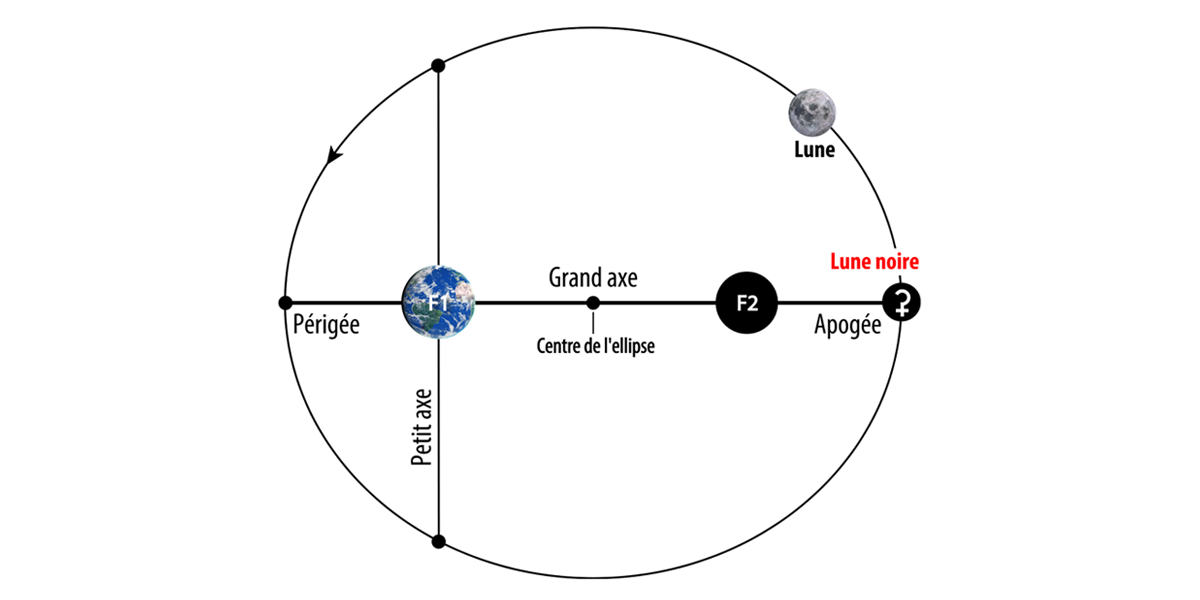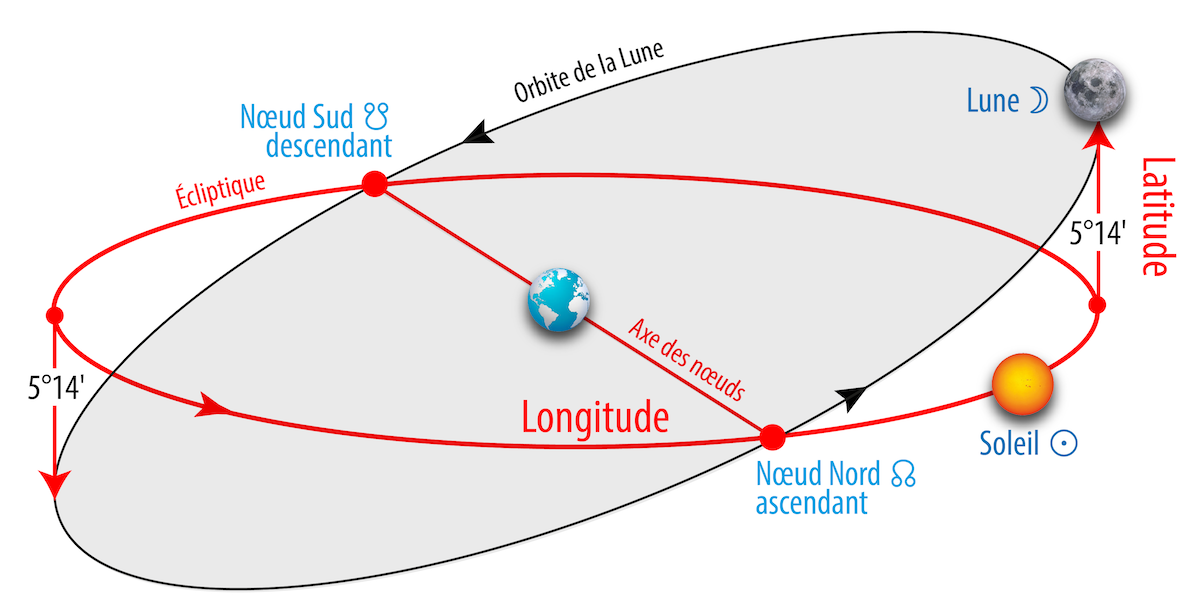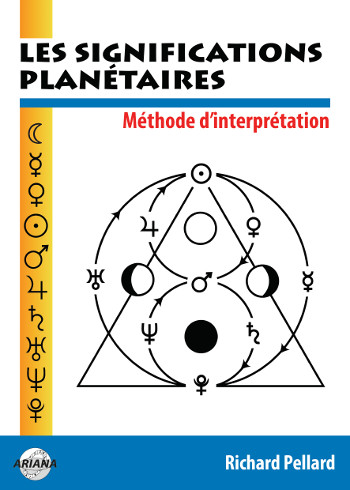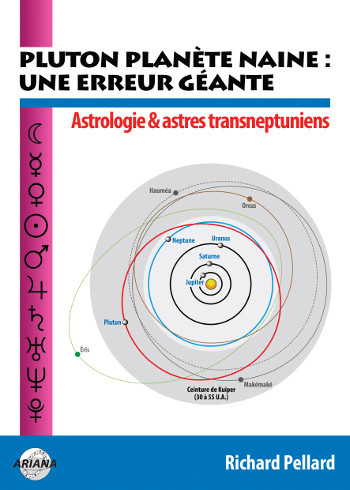Your Planets
Portraits of the Planets
Aspects between Planets
The planetary ages
The planetary families
Planets in Signs
The Planets in comics


The Black Moon is not a celestial body; it has no material existence. It’s a empty dot which represents the second focus of the lunar orbit.
The Moon’s orbit is not circular, but elliptical. Unlike a circle which has only one, an ellipse has two homes F1 and F2 being equidistant on either side of the center of the ellipse. In its course around the Earth, the Moon passes through two extreme points of its orbit:

▶ the perigee: the Moon is then closest to the Earth
▶ the apogee: the Moon is then farthest from the Earth
In the figure above, this ellipse has been greatly exaggerated for illustrative purposes. The first focus F1 is in the center of the Earth, while the second focus F2 is outside the earth mass. It’s the second home (F2) of the lunar orbit which is called Black Moon. We can project this empty astronomical point onto the plane of the ecliptic (zodiacal circle); we thus obtain the zodiacal positions of lunar apogee which determines the Sign of the Black Moon Head, and lunar perigee, which determines the Sign of the Black Moon Tail.
There are two methods of calculating the Black Moon:
▶ the Black Moon mean gives the zodiacal position of this empty point from the mean orbit of the Moon. The eccentricity variations of its ellipse are therefore not taken into account. The calculation of the position of the mean Black Moon is simple, but totally abstract and theoretical.
▶ the Black Moon corrected or true Black Moon gives the zodiacal position of this empty point from the actual orbit of the Moon. The eccentricity variations of its ellipse are therefore taken into account. The calculation of the position of the corrected or true Black Moon is very complex.
The astrologers who have studied the problem of the position of the Black Moon “true” are not in agreement with each other. Here are a few examples among others: Henri-Georges Gouchon, in his Dictionnaire astrologique (ed. Dervy-Livres), recommends a correction of ±5°, which is very “pifometric”; Guy Launay, in La Lune Noire (ed. Arjuna), recommends a correction of ±12.33°; André Danjon, in his book General astronomy, recommends a correction of ±8.7°… or 11.6°!
To make matters worse, some have even taken on the heavy task of calculating the position “interpolated” of the Black Moon, halfway to the “mean” and some “corrected”. In short, the mean Black Moon is pure theoretical fiction, and the true or interpolated Black Moon are mathematical puzzles with no known precise solution. What vain efforts to calculate the position of an empty point!
Also know that the true Black Moon has retrogradations and moves about 18 to 22 minutes a day when it is facing forward, whereas the mean Black Moon, which is always facing forward, has a daily stride of around 7 minutes. Due to the retrogradations of the true Black Moon, its positions each year periodically coincide with those of the mean Black Moon. Outside of these periods, the position in Sign and in House of these two Black Moons can be different. “AVERAGE” or “corrected”, the empty Black Moon point projected on the ecliptic moves about 40° per year and its revolution takes place in 3232 days (about 8 years and ten months).
Most of the books written on the Black Moon, its symbolism and its meanings are based on its average position, which is therefore most of the time false. This is not very serious, since it is an empty point: we do not ask fiction to be true.
All the stars of the solar system having more or less elliptical orbits, they all have, like the Moon, a second focus. Why do symbolist astrologers never mention Black Mercury, Black Venus, Black Mars, Black Jupiter, Black Saturn, Black Uranus, Black Neptune, Black Pluto? There is, however, a whole rich deposit of “poetic language” and of “symbolism” still untapped… Imagine, for example, the horrors that a astro-karmist about a retrograde and dissonant Black Pluto!
In addition, imagine your sky maps teeming with Dark Stars in addition to the real ones, not to mention other fictitious points such as the various Nodes (we will come back to this).
Let us now see what are the meanings attributed to the Black Moon. Logically, an empty dot should mean nothing… or else become an incredible reservoir of fables. This is obviously the second solution that irrationalist astronegroselenites of all stripes have chosen.
Let us note to begin with that for the Mesopotamians, discoverers of astrology, the Black Moon was by no means the second focus of the lunar orbit, since they were unaware that the stars had elliptical trajectories. For them, it was the second invisible satellite of the Earth, exactly opposite the real Moon and forever invisible, therefore fraught with all sorts of harrowing mysteries and virtual curses. This second mythical satellite, a new empty point to which particularly imaginative astrologers attribute a diameter four times smaller than that of the Moon, was later baptized with the name of Lilith. It was the English astrologer Sepharial (1864–1929) who imposed Lilith and its procession of overwhelming meanings. Since then, multiple and various aircraft have criss-crossed the skies around the Earth, and we know for certain that Lilith does not exist.
This proven non-existence did not discourage the astro-negroselenites: until around 1935, the belief in Satellite-Lilith continued. And it was in 1937 that the astrologer Dom Néroman invented the current Black Moon by transferring the meanings initially attributed to the second fictitious satellite of the Earth by Sepharial to the second focus of the lunar orbit… and this is how during of the 20th century the Black Moon was renamed Lilith. A non-existent star has been replaced by an empty point whose precise location is uncertain.
In 1971, particularly enthusiastic American astrologers published the first ephemeris of the Black Moon. They are false, since they are calculated according to the average position, but they are a hit with ignorant astro-irrationalists: a modern myth is born. Since then, works dealing with the new Black Moon have proliferated like weeds, each new author making it a point of honor to add his delusions of interpretation to those of his predecessors. Some have even made a very profitable business out of it. In his Dictionnaire astrologique, Henri Gouchon relates with amazement the following anecdote: “One evening I heard a celebrity’s rendition of Heaven where only the Black Moon was mentioned to explain his entire career!”
A little later, the astro-karmists appropriated the Black Moon to make it a storage center for “data going back to our past lives”. Could it be possible that we reincarnate in empty points? What prodigious metaphysics!
We have seen that the astronegroselenites are divided between partisans of the mean, corrected or interpolated Black Moon. They also split into supporters of Black Moon-Lilith and Black Moon-Black Moon. Explanation: if the former have swallowed without complaining the snake of the transfer of significations from the fictitious satellite of the Earth to the second focus of the lunar orbit, the latter, a little less incoherent, refuse to eat of this serpent. For the latter, who are very few in number, it is heresy to confuse the new Black Moon, “actor inherent in the lunar cycle”, invented by Dom Néroman with the Lilith of Sépharial.
To finish the 20th century in beauty, the astrologer Jean Billon decided that the “true” Lilith was neither an imaginary satellite of the Earth, nor the second focus of the lunar orbit, but… a asteroid belonging to the belt of stars in orbit between Mars and Jupiter, whose duration of revolution would be four 1/3 years. Billon does not specify whether or not he takes into account the second focus of Lilith’s orbit, that is to say the Black Lilith, in his interpretations of charts. Imagine the devastating feminist-karmic effects of a Black Moon-Black Lilith conjunction.
For most Astronegroselenites, Black Moon = Lilith. So let’s go into the myth of Lilith, which has absolutely nothing to do with traditional astrology. According to Jewish Kabbalah, Lilith is the name of the woman created before Eve and at the same time as Adam. She would have been born directly from the Earth and not from Adam’s rib: this “first eve” would thus be the archetype of the woman “free”, equal of man, emancipated from his coastguard domination.
Of course, in the macho world of Bible, rebellious Lilith quickly made herself look bad. She was accused of encouraging illegitimate love, even androgyny or incest. It was therefore decided to domicile her in the depths of the oceans so that she would not disturb the exemplary life of legitimate couples on the surface of the Earth. Relegated, abandoned, cloistered woman, she will nourish the hatred of the family and the position of the missionary, the refusal to integrate into the frameworks of conventional existence, and her tormented soul will be consumed in the perversion of an impossible desire and obscure impulses, devouring babies and suffering from a sickly jealousy.
What does this Hebrew myth have to do with the second focus of the lunar orbit? Nothing, absolutely nothing, and this all the more so since Judaism has always been unfavorable to astrology, which it considers to be idolatry. Here, the most basic and primitive analogism reigns supreme: “‘White’ moon = ‘good’ woman, hence Eve, etc.; Black Moon = woman of bad life, temptress, so Lilith, etc.” We are immersed in the most total irrationality, all the more so since it was Eve who was the real temptress of Adam. Locked in her oceanic abyss, Lilith did not have the possibility. Would Eve be in it “blackened”, Guilty and Lilith “whitened”, exonerated?
Needless to say that conditionalist astrology does not subscribe to this irrationalist nonsense. Women do not need the Black Moon to free themselves.
Recall that the Black Moon indicates the position of the Moon when it is at its apogee, that is to say furthest from the Earth, and that the Tail of the Black Moon therefore indicates the position of the Moon when it is at its perigee, that is to say closest to the Earth.
The Tail of the Black Moon has been grossly underestimated and ignored by Astronegroselenites. Why wouldn’t the empty point of the lunar perigee also have an influence? Its meanings would then be exactly opposite to that of the climax. But if Lilith has a tail, is she still a femme fatale? Is the Tail of Lilith dominant in the Charts of the bisexuals or transsexuals? Faced with such dizzying questions, it is understandable that there is not a second to lose in the interpretation of the real planets…
The astronomical definition of the lunar Nodes poses less of a problem: they are the two points of intersection between the planes of the lunar orbit and the ecliptic (apparent geocentric orbit of the Sun). They are also called the Dragon’s Head (North Node or Ascendant designating the moment when the Moon begins its trajectory above the plane of the ecliptic) and the Dragon’s Tail (South Node or Descendant indicating the moment when the Moon begins its trajectory below the plane of the ecliptic).

Unlike the Black Moon, the lunar Nodes are part of the astrological tradition. They are particularly important in Indian astrology and Tibetan (Rahu and Ketu). Their period is about 18.6 years; they reverse halfway and return to their initial position after 9.3 years. They are used to determine the times of soli-lunar eclipses.
For classical astro-symbolism, the North Node is a principle of “expanding, radiant, active, positive”, while the South Node is a principle of “contraction, absorbing, feminine, passive, negative”. Here we recognize machismo and traditionalist sexism: the masculine is “above” and the feminine “below”.
For astro-karmism, the North Node relates to the assets of previous incarnations and the South Node to their liabilities. According to Laurence Larzul, “When the North Node is superimposed on the South Node, it is generally a return to the karmic past which must instill a new start from the North Node”. Karmic astrology is very Knot-Knot…
Many astrologers believe that the Nodes are in themselves devoid of any influence: they must be conjoined or in Aspect to a planet for this non-influence to be felt, which is really very very mysterious.
Let’s drop this sexist and reincarnationist nonsense and ask ourselves the question: do the lunar Nodes have any real influence? From a purely astronomical point of view, when the Moon is between the North Node and the South Node, it has a North ecliptic latitude; it is the opposite when it is between the South Node and the North Node. The problem then comes down to asking whether the positive and negative ecliptic latitudes exert an influence (“radiant” North, “absorbent” in the South), why or why not. Answer: nothing like this has ever been observed… which does not mean that it will not happen one day.
We can also pose the problem differently: the lunar Nodes only exist in relation to an arbitrary reference plane: the ecliptic, apparent geocentric orbit of the Sun. If one decides to set aside this reference plane, there are no more lunar nodes, except when the soli-lunar eclipses occur; there are only North or South lunar declinations with respect to the equatorial plane.
Finally, it should be remembered that all the planetary orbits being also inclined on the ecliptic plane, each planet has its own North or South Node. If one decides to attribute an influence to the lunar nodes, consistency requires that one do the same for all the planetary nodes.
Now try to imagine yourself in front of your chart of the Sky with its ten real planets, its ten Black planets and Tails of Black planets and its nine pairs of Nodes. Add a few Parts, mix the Aspects and the positions in Signs and Houses of all this little world, serve hot and interpret. Courage!
▶ Simplified cosmography of the solar system
▶ La Lune astronomique
▶ The lunar function (homogeneous wholeness)
▶ Lunar stage (from 0 to 1 month old): the age of communion
▶ L’astrologie sidéraliste, une astrologie sidérante

Les significations planétaires
par
620 pages. Illustrations en couleur.
La décision de ne traiter dans ce livre que des significations planétaires ne repose pas sur une sous-estimation du rôle des Signes du zodiaque et des Maisons. Le traditionnel trio Planètes-Zodiaque-Maisons est en effet l’expression d’une structure qui classe ces trois plans selon leur ordre de préséance et dans ce triptyque hiérarchisé, les Planètes occupent le premier rang.
La première partie de ce livre rassemble donc, sous une forme abondamment illustrée de schémas pédagogiques et tableaux explicatifs, une édition originale revue, augmentée et actualisée des textes consacrés aux significations planétaires telles qu’elles ont été définies par l’astrologie conditionaliste et une présentation détaillée des méthodes de hiérarchisation planétaire et d’interprétation accompagnées de nombreux exemples concrets illustrés par des Thèmes de célébrités.
La deuxième partie est consacrée, d’une part à une présentation critique des fondements traditionnels des significations planétaires, d’autre part à une présentation des rapports entre signaux et symboles, astrologie et psychologie. Enfin, la troisième partie présente brièvement les racines astrométriques des significations planétaires… et propose une voie de sortie de l’astrologie pour accéder à une plus vaste dimension noologique et spirituelle qui la prolonge et la contient.
Téléchargez-le dès maintenant dans notre boutique

Pluton planète naine : une erreur géante
par
117 pages. Illustrations en couleur.
Pluton ne fait plus partie des planètes majeures de notre système solaire : telle est la décision prise par une infime minorité d’astronomes lors de l’Assemblée Générale de l’Union Astronomique Internationale qui s’est tenue à Prague en août 2006. Elle est reléguée au rang de “planète naine”, au même titre que les nombreux astres découverts au-delà de son orbite.
Ce livre récapitule et analyse en détail le pourquoi et le comment de cette incroyable et irrationnelle décision contestée par de très nombreux astronomes de premier plan. Quelles sont les effets de cette “nanification” de Pluton sur son statut astrologique ? Faut-il remettre en question son influence et ses significations astro-psychologiques qui semblaient avérées depuis sa découverte en 1930 ? Les “plutoniens” ont-ils cessé d’exister depuis cette décision charlatanesque ? Ce livre pose également le problème des astres transplutoniens nouvellement découverts. Quel statut astrologique et quelles influences et significations précises leur accorder ?
Enfin, cet ouvrage propose une vision unitaire du système solaire qui démontre, chiffes et arguments rationnels à l’appui, que Pluton en est toujours un élément essentiel, ce qui est loin d’être le cas pour les autres astres au-delà de son orbite. Après avoir lu ce livre, vous saurez quoi répondre à ceux qui pensent avoir trouvé, avec l’exclusion de Pluton du cortège planétaire traditionnel, un nouvel argument contre l’astrologie !
Téléchargez-le dès maintenant dans notre boutique